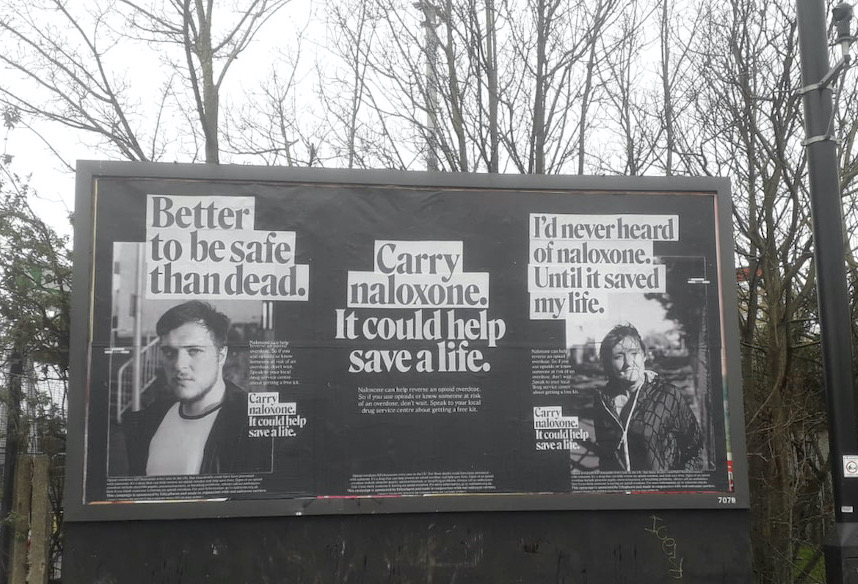Given the high prevalence of opioid mortality rates around the globe, naloxone, an opioid antagonist, has become a crucial medication that can reverse an opioid overdose within minutes. In an attempt to bring naloxone into the community, take-home naloxone programmes provide naloxone kits together with training in overdose management and administration to members of the public.
Studies show that the estimated survival times of an opioid overdose exceeds 20-30 minutes, giving us a window of opportunity to use naloxone and save a life. take-home naloxone kits support anyone who witnesses an opioid overdose and is carrying take-home naloxone to administer it, filling a life-threatening gap between an overdose and the access to a medical emergency service.
In the UK, take-home naloxone can be given to anyone involved with drug-related services without the need of a prescription. People can therefore access support through various different settings such as needle syringe programmes, drug treatment services or hostels and housing services whose clients are opioid users in treatment. With this community approach, take-home naloxone has provided a wide safety net to people that in one way or another are able to access a drug service. However, what happens to those that have no contact with these services and are therefore unable to access necessary outreach services?
Even if there are technically no legal barriers to accessing take-home naloxone programmes, many opioid users, as well as their friends and family members, have no contact with these services or are unaware that they could carry naloxone and receive training to be able to administer it. This is concerning given that most opioid overdose deaths happen outside of treatment services. Thus, the lives of many opioid users are left to chance when they could so easily benefit from lifesaving support.
Scotland’s Naloxone Peer Education Programme
Many lessons in community outreach for overdose prevention can be learned from Scotland, who are playing a crucial role in narrowing the gap between drug services and those who need them. The Scottish Drugs Forum established a National Naloxone Peer Education Programme back in 2012, where people who use drugs, have a history of drug use, or are family members of people who use opioids are recruited to engage with people outside of services, providing them with training and naloxone kits. Moreover, they developed an online training system so that anyone can learn how to identify and prevent an opioid overdose using naloxone kits.
Frontline staff such as librarians, bin workers and people supporting the homeless have been offered voluntary training for naloxone provision in Scotland. Even some police officers, who are the primary enforcers of the UK’s punitive drug laws, have responded positively to naloxone now that they've been trained to administer it. With these advances, Scotland has been able to put their most vulnerable and isolated communities first, setting an example to their neighbouring regions.
What else could be done to improve access?
One line of action to improve the provision of take-home naloxone could be to supply harm reduction kits at GPs, similar to sexual health kits that include free condoms and other paraphernalia and information. Distribution points could be implemented in key community areas and awareness of the opportunities to receive training could be generally increased.
Arguably, the national implementation of safe consumption rooms or overdose prevention sites, such as Peter Krykant’s Overdose Prevention Van, is the most safe and effective way to reach out to more people in the community and at street level and to prevent opioid overdose.
Though the latter has proven to be a highly effective and widespread public health response to tackle drug-related deaths, there are still legal road blocks to live-saving harm reduction for people who use drugs in the UK.
We asked some of the experts in this field to give us their ideas about how we should be moving forward to increase take-home naloxone access across England.
George Charlton, developer of Peer-to-Peer Naloxone Training and Supply across North East of England commented on the importance of widening naloxone access stating that:
Typically owing to high caseloads drug users may only spend 20 minutes with their key workers and then leave and go home to a family member or significant other. Family members need to be shown skills which will enable them in many ways to become the practitioner and also be trained and supplied with take-home naloxone. We also need to empower people who use drugs and enable them to go out into their communities and save the lives of their friends through peer-to-peer Naloxone programmes ensuring that no one walks away without a naloxone kit anymore.
Mat Southwell, EuroNPUD Project Executive says:
Take Home Naloxone has proved effective in opening up access to Naloxone for people in touch with drug services. People actively injecting heroin are most at risk and may be best reached through peer networks using a peer-to-peer Naloxone distribution approach.
Much needs to be made in order to improve take-home naloxone access in England , however, what cannot be missed is having a community approach where members of the public and people who use drugs play an active role.


